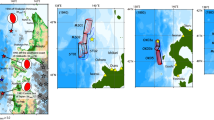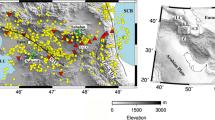Abstract
We present a modern seismological study of the earthquake of 26 June 1941 in the Andaman Islands, the largest pre-2004 event along that section of the India-Burma plate boundary. Despite a large conventional magnitude (\(M_{\text {PAS}} \,=\,8.1\)), it generated at best a mediocre tsunami for which no definitive quantitative reports are available. We show that the 1941 earthquake took place under the Andaman accretionary prism and consisted of a composite event, whose nucleating phase had a strike-slip mechanism incompatible with a data set of spectral amplitudes of mantle Rayleigh and Love waves. Combining this initial phase with a larger normal faulting mechanism can reconcile them with P-wave first motions, reports of subsidence on the eastern coast of the Andaman Islands and the small amplitudes of any putative tsunami. The small tsunami results from a combination of that mechanism and of a source located under the islands themselves and in shallow water, implying a reduction in amplitude under Green’s law when transitioning to a deeper basin.













Similar content being viewed by others
References
Abe, K. (1981). Magnitudes of large shallow earthquakes from 1904 to 1980. Physics of the Earth and Planetary Interiors, 27, 72–92.
Bilham, R., Engdahl, E. R., Feldl, N., & Satyabala, S. P. (2005). Partial and complete rupture of the Indo-Andaman plate boundary, 1847–2004. Seismological Research Letters, 76, 299–311.
Bird, P. (2003). An updated digital model of plate boundaries. Geochemistry, Geophysics, Geosystems, 4(3), GC000252.
Boen, T. (2006). Sructural damage in the March 2005 Nias-Simeulue earthquake. Earthquake Spectra, 22, S419–S434.
Brune, J. N. (1968). Seismic moment, seismicity, and rate of slip along major fault zones. Journal of Geophysical Research, 73, 777–784.
Brune, J. N., & Engen, G. R. (1969). Excitation of mantle Love waves and definition of mantle wave magnitude. Bulletin of the Seismological Society of America, 59, 923–933.
Chlieh, M., Avouac, J.-P., Hjörleifsdóttir, V., Song, T.-R. A., Ji, C., Sieh, K., et al. (2007). Coseismic slip and afterslip of the great \(M_w \,=\, 9.15\) Sumatra-Andaman earthquake of 2004. Bulletin of the Seismological Society of America, 97, S152–S173.
Cochran, J. R. (2010). Morphology and tectonics of the Andaman Forearc, Northeastern Indian Ocean. Geophysical Journal International, 182, 631–651.
Courant, R., Friedrichs, K., & Lewy, H. (1928). Über die partiellen Differenzengleichungen der mathematischen Physik. Mathematische Annalen, 100, 32–74.
Curray, J. R. (2005). Tectonics and history of the Andaman Sea region. Journal of Asian Earth Sciences, 25, 187–232.
Dalrymple, R.A., & Derakhti, M. (2018). Tsunami generation by earthquakes: Seabed topography and inertial effects. In: Proceedings 36th international conference on coastal engineering, 1605, Baltimore [abstract].
Diehl, T., Waldhauser, F., Cochran, J. R., Kamesh Raju, K. A., Seeber, L., Schaff, D., et al. (2013). Back-arc extension in the Andaman Sea: Tectonic and magmatic processes imaged by high-precision teleseismic double-difference earthquake relocation. Journal of Geophysical Research: Solid Earth, 118, 2206–2224.
Dziewonski, A. M., Chou, T. A., & Woodhouse, J. H. (1981). Determination of earthquake source parameters from waveform data for studies of global and regional seismicity. Journal of Geophysical Research, 86, 2825–2852.
Ebel, J. E., & Chambers, D. W. (2016). Using the locations of \(M \, \ge \,4\) earthquakes to delineate the extents of the ruptures of past major earthquakes. Geophysical Journal International, 207, 862–875.
Ekström, G., Nettles, M., & Dziewoński, A. M. (2012). The global CMT project, 2004–2010: Centroid moment tensors for 13,107 earthquakes. Physics of the Earth and Planetary Interiors, 200, 1–9.
Engdahl, E. R., & Villaseñor, A. (2002). Global seismicity: 1900–1999. In International earthquake and engineering seismology Part A (pp. 665–690). New York: Elsevier.
Fitch, T. J. (1972). Plate convergence, transcurrent faults, and internal deformation adjacent to Southeast Asia and Western Pacific. Journal of Geophysical Research, 77, 4442–4460.
Frohlich, C., & Apperson, K. D. (1992). Earthquake focal mechanisms, moment tensors, and the consistency of seismic activity near plate boundaries. Tectonics, 11, 279–296.
Geller, R. J. (1976). Scaling relations for earthquake source parameters and magnitudes. Bulletin of the Seismological Society of America, 66, 1501–1523.
Godunov, S. K. (1959). Finite difference methods for numerical computations of discontinuous solutions of the equations of fluid dynamics. Matematicheskiĭ Sbornik, 47, 271–295.
Goodstein, J. R., Kanamori, H., & Lee, W. H. K. (1980). Seismology microfiche publications from the Caltech archives. Bulletin of the Seismological Society of America, 70, 657–658.
Green, G. (1837). On the motion of waves in a canal of variable depth. Cambridge Philosophical Transactions, 6, 457–462.
Gutenberg, B., & Richter, C. F. (1954). Seismicity of the Earth and associated phenomena. Princeton: Princeton University Press.
Ishii, M., Shearer, P. M., Houston, H., & Vidale, J. E. (2005). Extent, duration and speed of the 2004 Sumatra–Andaman earthquake imaged by the Hi-Net array. Nature, 435, 933–936.
Jhingran, A. G. (1953). A note on the earthquake in the Andaman Islands (26 June 1941). Records of the Geological Survey of India, 82, 300–307.
Kagan, Y. Y. (1991). 3-D rotation of double-couple earthquake sources. Geophysical Journal International, 106, 709–716.
Kanamori, H. (1977). The energy release in great earthquakes. Journal of Geophysical Research, 82, 2981–2987.
Lorito, S., Piatanesi, A., Cannelli, V., Romano, F., & Melini, D. (2010). Kinematics and source zone properties of the 2004 Sumatra-Andaman earthquake and tsunami: Nonlinear joint inversion of tide gauge, satellite altimetry, and GPS data. Journal of Geophysical Research, 115(B2), B02304.
Mansinha, L., & Smylie, D. E. (1971). The displacement fields of inclined faults. Bulletin of the Seismological Society of America, 61, 1433–1440.
Murty, T.S. (1984). Storm surges: Meteorological ocean tides, Can. Bull. Fisheries Aquat. Sci., 212, Dept. Fisheries Oceans, Ottawa.
Murty, T. S., & Rafiq, M. (1991). A tentative list of tsunamis in the Indian Ocean. Natural Hazards, 4, 81–83.
Okal, E. A. (2005). A re-evaluation of the great Aleutian and Chilean earthquakes of 1906 August 17. Geophysical Journal International, 161, 268–282.
Okal, E. A. (2015). Historical seismograms: Preserving an endangered species. GeoResJ, 6, 53–64.
Okal, E. A., Kirby, S. H., & Kalligeris, N. (2016). The Showa Sanriku earthquake of 1933 March 2: A global seismological reassessment. Geophysical Journal International, 206, 1492–1514.
Okal, E. A., & Saloor, N. (2017). Historical tsunami earthquakes in the Southwest Pacific: An extension to \(\Delta \,>\, 80^{\circ }\) of the Energy-to-Moment parameter \(\Theta \). Geophysical Journal International, 210, 852–873.
Okal, E. A., & Stein, S. (2009). Observations of ultra-long period normal modes from the 2004 Sumatra-Andaman earthquake. Physics of the Earth and Planetary Interiors, 175, 53–62.
Okal, E. A., & Synolakis, C. E. (2008). Far-field tsunami hazard from mega-thrust earthquakes in the Indian Ocean. Geophysical Journal International, 172, 995–1015.
Okal, E. A., & Talandier, J. (1989). \(M_m\): A variable period mantle magnitude. Journal of Geophysical Research, 94, 4169–4193.
Ortíz, M., & Bilham, R. (2003). Source area and rupture parameters of the 31 December 1881 \(M_w \,=\, 7.9\) Car Nicobar earthquake estimated from tsunamis recorded in the Bay of Bengal. Journal of Geophysical Research, 108(B4), 2215.
Rajendran, C. P. (2013). Was the 1941 Andaman earthquake tsunamigenic? Comments on “Inundation studies for Nagapattinam region on the East coast of India due to tsunamigenic earthquakes from the Andaman region” by Srivastava et al. Natural Hazards, 65, 981–984.
Ramana Murthy, M. V., Usha, T., Pari, Y., & Reddy, N. T. (2011). Tsunami vulnerability assessment of Cuddalore using numerical model and GIS. Marine Geodesy, 34, 16–28.
Rees, B. A., & Okal, E. A. (1987). The depth of the deepest historical earthquakes. Pure and Applied Geophysics, 125, 699–715.
Reymond, D., & Okal, E. A. (2000). Preliminary determination of focal mechanisms from the inversion of spectral amplitudes of mantle waves. Physics of the Earth and Planetary Interiors, 121, 249–271.
Richter, C. F. (1958). Elementary seismology. San Francisco: Freeman.
Ritsema, A. R., & Veldkamp, J. (1960). Fault plane mechanisms of Southeast Asian earthquakes. Publ. Koninkl. Nederl. Meteorolog. Inst., 72, 63. (De Bilt).
Saito, T., & Furumura, T. (2009). Three-dimensional tsunami generation simulation due to sea-bottom deformation and its interpretation based on the linear theory. Geophysical Journal International, 178, 877–888.
Salaree, A., & Okal, E. A. (2018). The “tsunami earthquake” of 13 April 1923 in Northern Kamchatka: Seismological and hydrodynamic investigations. Pure and Applied Geophysics, 175, 1257–1285.
Sella, G. F., Dixon, T. H., & Mao, A. (2002). REVEL: A model for Recent plate velocities from space geodesy. Journal of Geophysical Research, 107(B4), ETG-11.
Smyshlyaev, A. A. (2003). Vremya krasnoĭ ryby, pp. 310–315. Petropavlovsk-Kamchatskiĭ: Novaya Kniga [in Russian].
Srivastava, K., Krishna Kumar, R., Swapna, M., Swaroopa Rani, V., & Dimri, V. P. (2012). Inundation studies for Nagapattinam region on the East coast of India due to tsunamigenic earthquakes from the Andaman region. Natural Hazards, 63, 211–221.
Storchak, D. A., Di Giacomo, D., Engdahl, E. R., Harris, J., Bondár, I., Lee, W. H. K., et al. (2015). The ISC-GEM global instrumental earthquake catalogue (1900–2009): Introduction. Physics of the Earth and Planetary Interiors, 239, 48–63.
Synolakis, C. E. (2003). Tsunami and seiche. In W.-F. Chen & C. Scawthron (Eds.), Earthquake engineering handbook (pp. 9_1–9_90). Boca Raton: CRC Press.
Synolakis, C., Bernard, E., Titov, V., Kânoğlu, U., & González, F. (2008). Validation and verification of tsunami numerical models. Pure and Applied Geophysics, 165, 2197–2228.
Titov, V., Kânoğlu, U., & Synolakis, C. (2016). Development of MOST for real-time tsunami forecasting. Journal of Waterway Port Coastal and Ocean Engineering, 142(6), 03116004.
Titov, V. V., & Synolakis, C. E. (1998). Numerical modeling of tidal wave runup. Journal of Waterway Port Coastal and Ocean Engineering, 124, 157–171.
Tsai, V. C., Nettles, M., Ekström, G., & Dziewonski, A. M. (2005). Multiple CMT source analysis of the 2004 Sumatra earthquake. Geophysical Research Letters, 32(17), L17304.
Wessel, P., & Smith, W. H. F. (1991). Free software helps map and display data. Eos Transactions American Geophysical Union, 72, 441 and 445–446.
Wickens, A.J., & Hodgson, J.H. (1967). Computer re-evaluation of earthquake mechanism solutions, 1922–1962. Publications of the Dominion Observatory, Ottawa (vol. 33, no. 1). Ottawa: Dept. Energy, Mines, Res.
Wysession, M. E., Okal, E. A., & Miller, K. L. (1991). Intraplate seismicity of the Pacific Basin, 1913–1988. Pure and Applied Geophysics, 135, 261–359.
Acknowledgements
We are grateful to Ian Saunders (Pretoria), Bernard Dost (De Bilt) and Brian Ferris (Lower Hutt) for access to the excellent seismological archives at their respective facilities. Some figures were drawn using the GMT software (Wessel and Smith 1991). The paper benefited from the constructive comments of two anonymous reviewers.
Author information
Authors and Affiliations
Corresponding author
Additional information
Publisher's Note
Springer Nature remains neutral with regard to jurisdictional claims in published maps and institutional affiliations.
Rights and permissions
About this article
Cite this article
Okal, E.A. The Large Andaman Islands Earthquake of 26 June 1941: Why No Significant Tsunami?. Pure Appl. Geophys. 176, 2869–2886 (2019). https://doi.org/10.1007/s00024-018-2082-8
Received:
Revised:
Accepted:
Published:
Issue Date:
DOI: https://doi.org/10.1007/s00024-018-2082-8




